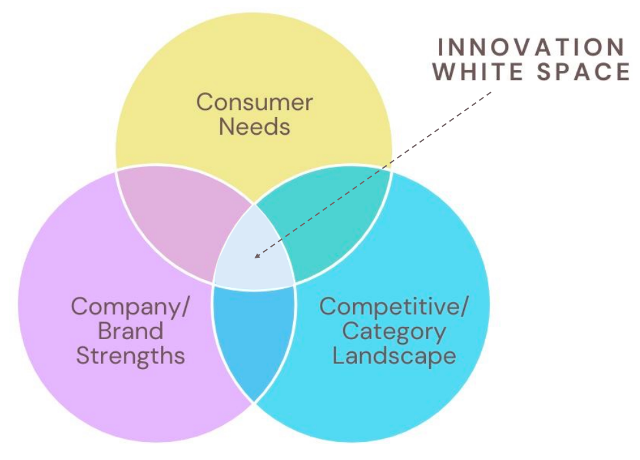The 3 Cs framework is a foundational tool that I learned in business school, and was a mnemonic device that I found useful in strategy and marketing classes to evaluate case studies and solve problems. It’s simple, yet it effectively helps you cover your bases when thinking through the levers to pull or gaps to fill to drive business strategy.
The ‘fuzzy front end’ of innovation, during which ideas are generated, concepts are explored, and potential opportunities are identified, can feel unstructured and ambiguous. While certainly it’s important to allow for creativity and ambiguity during this phase, the 3 Cs can help provide a little structure to an inherently unstructured process. It provides focus by looking at the marketplace from many angles to find the ‘white space’ where innovation opportunities live.

Here’s an overview of the 3 Cs and how they can apply to innovation:
Consumer Needs: Starting with the consumer is the foundation of any innovation strategy. What are their unmet needs? What needs are emerging? How do we anticipate their needs changing over time?
Competitive/Category Landscape: It’s also critical to understand the broader category and competitive landscape. What do your competitors do well, and where are they weak? Where do we anticipate them moving? This analysis should also include a broader look at the category/industry dynamics, and how those are evolving or being disrupted.
Company Strengths: Finally, defining your brand or company core capabilities (particularly in relation to the category where you want to innovate) can help you define where to play. Evaluate where your leverage is today, but also consider how it will evolve in the future.
At the intersection of these Cs lies potential ‘white space’ ripe for innovation: An emerging unmet need, where your brand or company has leverage, and your competitors are weak. This ‘white space’ is a starting point that helps you focus idea generation and concept development – and can make the ‘fuzzy front end’ a little clearer.
An example to bring this framework to life is from an innovation project in the antacids category. We found that consumers often suffered from heartburn and reflux at night when they laid down to sleep. This interfered with quality sleep, a topic gaining momentum as the healthcare industry stressed the importance of quality sleep for overall wellness. At the same time, the broader competitive analysis revealed that innovation was focusing on more severe, chronic heartburn and advanced medications that were coming off patent protection. Finally, the brand had a differentiated equity in fast relief. The intersection of these needs and marketplace dynamics revealed a ‘white space’ around the nighttime occasion where there was a need gap in heartburn relief and quality sleep. This resulted in a new concept for a fast-acting antacid with the added benefit of a gentle sleep aid, which has successfully been launched in the marketplace.
We at Southpaw Insights can help you put the fuzzy front end of innovation into better focus – with our skilled research team and forward-thinking trend partners, we can mine the 3 Cs to find your brand’s ‘white space’ – the springboard for breakthrough ideas.



